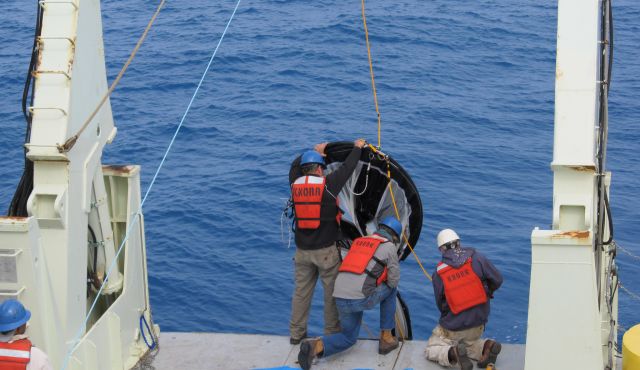
The expedition in the north Atlantic Ocean. Photo by Assaf Vardi
As the northern hemisphere sweltered in summer, more than 30 scientists, led by an Israeli biologist, were spending the month of June on a ship in the north Atlantic Ocean. Their mission: to find green slime. Or more specifically — blankets of phytoplankton: single-cell algae that grow in masses on the ocean’s surface. These blankets can grow to thousands of square kilometers.
Why were they combing the high seas for marine mulch? Because these microscopic flora are a crucial platform for the planet’s ecology, and are key to climate regulation in particular. Their hope is that studying the algae at the micro level will lead to macro understanding of the role the marine weed plays in the planet’s ecological system.
Dr. Assaf Vardi of the Weizmann Institute conceived of this voyage over three years ago, while doing his post-doctorate at the École Normale Supérieure in Paris and later at Rutgers University. Thus in June, Vardi and an international group of scientists set sail from the Azores Islands to the deep seas off Iceland in search of these algal blooms, to gain deeper understanding of the biochemical processes that control their cyclic bloom and collapse.
The group included Dr. Daniella Schatz, Dr. Miguel Frada, Uri Sheyn, Shiri Graff, Shlomit Sharoni and Dr. Yoav Lehahn from the Plant Sciences department at the Weizmann Institute, plus colleagues from Charleston University, Rutgers University and the Woods Hole Oceanographic Institute at Cape Cod.
Phytoplankton play a tremendous role in the Earth’s ecology and in sustaining life on our planet. Though constituting only 1 percent of the planet’s biomass, phytoplankton are responsible for 50 percent of all photosynthesis taking place on Earth.
During photosynthesis, plants breathe in carbon dioxide and breathe out oxygen. Through the photosynthetic process that feeds them, the single-cell algae are the planet’s most central absorbers of carbon dioxide: They breathe it in so they can create the oxygen that fills our own lungs and rules our lives.
“If we got rid of all the phytoplankton in the oceans, there would be 42% more carbon dioxide in the atmosphere,” estimates Vardi. “On the other hand, we would have 50% less oxygen on Earth.”
Eons of bloom and bust
Phytoplankton are at the base of the oceanic food chain. These oozy blankets have been blooming and collapsing for eons. Massive primordial blooms and their subsequent collapses, accumulating over time, are responsible for the oil we use today to fuel modern civilization.
Scientists want to understand how global warming and the rising proportion of carbon dioxide in the atmosphere affects — and is affected by — the phytoplankton patches.

Phytoplankton are at the base of the oceanic food chain. These oozy blankets have been blooming and collapsing for eons. Photo by Reuters
When the algae dies and sinks to the bottom of the ocean, only a small percentage of the carbon dioxide is buried with it. The researchers are set on cracking their ecological code, and finding what specific processes affect the percentage of carbon dioxide that is permanently removed from the atmosphere.
In recent years researchers have learned that one of the main regulators of these algal blooms and implosions are deep-ocean giant viruses, says Vardi. Their role in the carbon cycle in the ocean made them one of the voyage’s main study targets, he says.
“The underlying hypothesis is that marine viruses play a role in regulating algal blooms and therefore play a key role in the fate of organic and inorganic carbon in the ocean,” he explains.
Ultimately, the team hopes to see the big picture of how viral infection regulates the downward flux of carbon to the deep ocean.
The researchers collected hundreds of samples of algae, and the viruses that attack them, for genetic analysis in the upcoming months.
Algae and the clouds that rain on you
Phytoplankton also affect the creation of clouds, a phenomenon the scientists set out to study and quantify by measuring aerosol concentration (solid particles suspended in gas) dozens of meters over sea-level.
The algae not only breathe out oxygen, they release sulfur particles that serve as the cloud condensation nuclei. The team is working with Prof. Ilan Koren of the Weizmann Institute, an expert on cloud physics, to link the micro and macro scales in the various feedback mechanisms, Vardi adds.
This research may benefit climate researchers, since clouds and their capacity to reflect back the sun’s radiation are a central, yet largely not understood, parameter in climate change.
“It took us ten days to reach the phytoplankton patches in the sea,” says Vardi. “It was incredible. Each patch was as much as 100 to 1000 kilometers wide. We worked 24/7. Now we’re waiting for preliminary results, but it will take some months of analysis before they arrive.”
